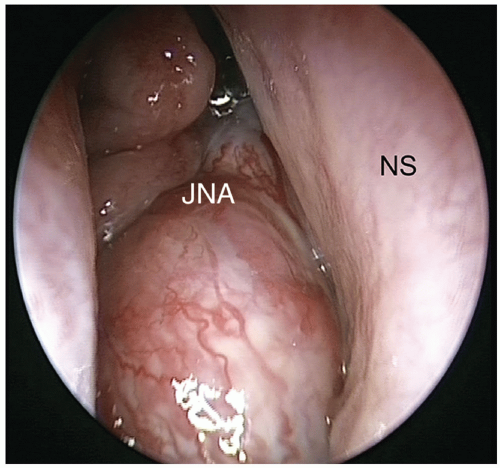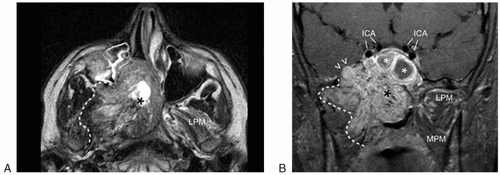Endoscopic Transmaxillary Approach To The Infratemporal Fossa (Endoscopic Denker Procedure)
Piero Nicolai
INTRODUCTION
The infratemporal fossa (ITF) is a complex anatomic area located deep to the ramus of the mandible and inferior to the zygomatic arch. The anterior boundary is formed by the posterior surface of the maxilla, the lateral by the ramus of the mandible, the posterior by the articular tubercle of the temporal bone and the styloid process, and the medial by the lateral pterygoid plate and the superior constrictor muscle. The pterygomaxillary fissure, which is located between the posterior wall of the maxilla and the pterygoid process, creates a connection between the ITF and the pterygopalatine fossa (PPF) and, more medially, through the pterygopalatine foramen, with the nasal cavity. The superior limit of ITF is formed medially by the infratemporal surface of the greater wing of the sphenoid and the squamous temporal bone, while laterally there is free communication with the temporal fossa. The medial pterygoid muscle is commonly identified as the inferior limit of the ITF, although posterior to this muscle there is communication with tissue spaces in the neck.
If one thinks of the ITF as an irregularly shaped box that contains muscles (pterygoids, distal part of the temporalis), arteries (internal maxillary artery and its branches), veins (pterygoid plexus), and nerves (second and third division of the trigeminal nerve with some of their branches, auriculotemporal nerve) and is connected with several adjacent anatomic areas, it is intuitive that a variety of inflammatory and neoplastic processes can originate there or, more frequently, spread secondarily from neighboring regions such as the sinonasal tract, nasopharynx, mandible, parotid gland, and cranial cavity. The possibility of hematogenous metastases, although extremely rare, should not be overlooked.
Management of lesions arising in the ITF has traditionally been considered a challenge for the head and neck surgeon, and many routes of access either alone (transmaxillary, transmandibular, facial translocation, maxillary swing approach, orbitozygomatic, infratemporal) or in combination have been proposed. However, all these procedures are associated with substantial aesthetic and functional morbidity, which appears unreasonable particularly when dealing with benign tumors.
During recent decades, the rapid evolution of endoscopic sinus surgery, refinements in morphologic imaging, improvements in surgical instrumentation and equipment (i.e., navigation systems, intraoperative CT or MRI), and a better understanding of the diseases being treated have pushed the indications well beyond the limits of the mere sinonasal complex.
Brors and Draf should be recognized as the first surgeons who reported on the use of a microendoscopic technique they defined as “enlarged endonasal maxillary sinus operation” or, subsequently, “endonasal Denker” to obtain complete exposure of the entire maxillary sinus in cases of inverted papilloma. However, the authors clearly stated that the technique had been described well before the advent of endoscopic surgery by Sturmann and Canfield in 1908.
The indications for this procedure, which included in its original version a medial maxillectomy with an ipsilateral anteromedial maxillotomy, have been expanded in order to gain access to anatomic structures located posterior to the maxillary sinus to resect expansile lesions of the ITF or, posterior to the pterygoid process, selected malignant lesions of the nasopharynx.
At the same time, several alternative techniques aimed at improving the exposure of the ITF and minimizing the morbidity of the approach have been described. These include a unilateral nasal endoscopic approach supplemented by a transoral Caldwell-Luc access; a combination of a two-nostril approach that can be achieved through a large posterior septectomy or a septal window, which is closed after dissection by preventively harvested bilateral nasoseptal flaps; and septal dislocation with access from the ipsilateral fossa.
As a last introductory comment, a recent comparative study performed at the Ohio State University on the volumetric analysis of endoscopic Denker approach and preauricular approach to the ITF demonstrated that the volumes for each approach were strikingly similar, thus suggesting that the fields of instrumentation and visualization are also analogous.
HISTORY
Most of the space-occupying lesions of the ITF are benign and slow growing and can reach a considerable size before giving rise to symptoms that can alert the patient and clinician, or even can be diagnosed by chance incidentally with imaging studies obtained for different reasons. The lesion that most frequently secondarily invades the ITF is the juvenile nasopharyngeal angiofibroma (JNA), a tumor associated with classical symptoms such as nasal obstruction and epistaxis. The presence of a swelling in the cheek is commonly indicative of extensive lateral growth of the lesion into the ITF; superior displacement of the globe may indicate a concomitant growth through the inferior orbital fissure into the orbit. The occurrence of unilateral eustachian tube dysfunction with a feeling of fullness and middle ear effusion is an additional situation caused by compression of the cartilaginous portion of the eustachian tube by the tumor. The complaint of facial numbness or paresthesia in the V1, V2, and V3 distribution; masticatory dysfunction; mild headache; or facial pain may suggest the presence of a schwannoma, but the most important concern of the clinician should be to rule out the presence of a malignancy associated with perineural spread such as adenoid cystic carcinoma. Trismus and pain are more commonly observed in malignant tumors of the maxillary sinus invading the ITF and specifically the muscles of mastication.
PHYSICAL EXAMINATION
As already mentioned, two main scenarios can be encountered: an otherwise asymptomatic patient with a diagnosis of an expansile lesion of the ITF as an incidental finding or a patient who presents with variable symptoms, frequently mild and vague, which cannot be neglected. Clinical examination begins with inspection of the face and the neck, which can detect swelling of the cheek, displacement of the globe, impairment of function of the extraocular muscles, or even trismus of variable degree. Palpation of the neck can identify the presence of enlarged suspicious lymph nodes. Special attention must be paid to evaluate any possible alteration of sensitivity in the territory of innervation of the branches of the trigeminal nerve.
Endoscopic examination of the nasal cavities and nasopharynx is aimed to identify any pathologic finding. This can range from a mass occupying the nasal cavity (Fig. 26.1) and nasopharynx, which in an adolescent
boy is highly suggestive of a diagnosis of JNA, to medialization of the posterior aspect of the lateral nasal wall covered by intact mucosa, which can indicate the presence of a space-occupying lesion of the pterygopalatine-ITF. In a patient with trismus, endoscopy can identify the presence of pathologic tissue in the nasal cavity, thus confirming the hypothesis of an advanced-stage cancer of the maxillary sinus.
boy is highly suggestive of a diagnosis of JNA, to medialization of the posterior aspect of the lateral nasal wall covered by intact mucosa, which can indicate the presence of a space-occupying lesion of the pterygopalatine-ITF. In a patient with trismus, endoscopy can identify the presence of pathologic tissue in the nasal cavity, thus confirming the hypothesis of an advanced-stage cancer of the maxillary sinus.
 FIGURE 26.1 Endoscopic view of a JNA completely obstructing the right nasal fossa. NS, nasal septum. |
Evaluation of the patient who complains of ear symptoms should include micro-otoscopy, pure tone audiometry, and tympanometry.
INDICATIONS
In my practice, the endonasal Denker procedure is most frequently performed for inverted papillomas, which extensively involve the maxillary sinus. In a series of 92 patients with the tumor originating in the maxillary sinus published by our group, we never had to resort to an external approach to obtain full visualization of the walls or to use a drill (straight or angled) to remove the bone underlying the diseased mucosa. However, the main focus of the present chapter is on the indications for the use of the endonasal Denker to remove tumors located in the ITF.
In view of its typical tendency to spread through fissures and foramina of the skull base, JNA expands from its epicenter into the PPF medially into the nasal cavity/nasopharynx and, in the opposite direction, laterally through the pterygomaxillary fissure into the ITF. The lesion not infrequently pushes anteriorly and thins the posterior wall of the maxillary sinus to the point that in some cases the sinus can be completely filled by the tumor. Minimal digitations into the ITF can be easily approached through a standard medial maxillectomy with partial resection of the posterior wall of the maxillary sinus. However, large-volume JNAs that extend far laterally to fill the entire ITF abutting on the mandible and/or invading the floor of the middle cranial fossa are ideal indications for an endonasal Denker.
In recent years, much interest has been given to the possibility of removing schwannomas of the ITF, which more frequently originate from the maxillary branch and extend posteriorly to the level of Meckel cave even occupying the middle cranial fossa more extensively through a purely endoscopic approach. Following the concept of modular approach, endonasal Denker can be also considered an excellent corridor for access to the retropterygoid area, the peritubal space, and the sphenoid sinus in cases of far laterally located meningoencephaloceles.
CONTRAINDICATIONS
Considering the constant evolution in the indications for endoscopic nasal and skull base surgery, there are still situations related to the nature (benign vs. malignant) and to the relationship of the lesion with specific anatomic structures (i.e., ICA [internal carotid artery], cavernous sinus, optic nerve) that challenge the decisionmaking process of approaching a specific lesion through a pure endoscopic approach, questioning whether an open or possibly combined technique might offer the chance of a more radical and less dangerous resection.
Endonasal Denker is an excellent approach for exposing and resecting any JNA that extends to involve the ITF. In fact, in my experience, I never had to resort to an additional approach for this specific extent. However, it is well known that encasement of the ICA, massive vascular supply from the ICA itself, and intradural extent may be situations in which it is advisable to plan an external procedure or, alternatively, to stage the procedure. The latter policy may be well adopted in the situation of massive intraoperative bleeding that can jeopardize the patient’s survival.
Trigeminal schwannomas that extend from their site of origin in the ITF and middle fossa to the posterior cranial fossa require a combination of an endoscopic approach with a retrosigmoid craniectomy, as shown by the experience of the Pittsburgh group.
At present, the experience in the management of malignancies of the ITF is so anecdotal that they should be excluded from routine indications, unless a palliative resection is the only alternative.
PRETREATMENT PLANNING
The general recommendation in a patient whose symptoms and physical examination are suspicious for an expansile lesion that involves the ITF is to first perform imaging studies, which commonly give enough details to suggest the diagnosis. Both multislice computed tomography (MSCT) and magnetic resonance (MR) with contrast medium are commonly requested to obtain better delineation of bone and soft tissue extension, respectively. In my experience, MR alone after administration of gadolinium and with the acquisition of all the required sequences (turbo spin-echo T2, spin-echo T1 pre- and postcontrast agent, gradient-echo T1-weighted postcontrast) is accurate enough to obtain sufficient information about the lesion for planning treatment:
Size, nature, and degree of vascularization
Primary or secondary involvement of the ITF
Expansile or invasive pattern of growth
Relationships of the lesion with the masticatory muscles, maxillary sinus, and skull base
Signs of perineural spread
Stay updated, free articles. Join our Telegram channel

Full access? Get Clinical Tree



